
Concept explainers
Interpretation:
The colouring properties in thegiven coordination compounds are to be explained.
Concept introduction:
The sunlight comprises all the colors. The objects reflecting all these colors appear white and the objects absorbing all these colors appear black. Any object that absorbs all colors but reflects a particular color is said to possess that color.
The colour in coordination compounds can be explained on the basis of crystal field splitting energy by using the expressionbelow:
Here,
The colour of a complex compound is the same as the magnitude of the energy of a photon of visible light. The
Spectrochemical series:
These ligands are arranged in order of increasing value of
Want to see the full answer?
Check out a sample textbook solution
Chapter 22 Solutions
Chemistry
- Question: Although both nitrogen and phosphorous take place in Group VA, in complex formation ammonia acts as sigma-donor while PR3 is both sigma–donor and pi-acceptor. In the light of this explanation, show the sigma and pi interactions in [Co(PR3)6]2+ according to MO theory. What makes PR3 a different ligand than ammonia? Do I need to replace t2g orbitals in my diagram? How can I show PR3 ligands using d orbitals?arrow_forwardWhat will be produced when combining molecules that contains two or more groups that donate electrons? CHOICES: a.Chelate b.Metalloid c.Ligand d.Complexarrow_forwardWhich of the following ligands does not interact with a transition metal center in a π fashion? Group of answer choices CO Cl- H2O bipyarrow_forward
- Which one of the following is the correct formula for the coordination compound triamminebromoplatinum(II) chloride? A. [Pt(NH3)3Br]Cl B. [Pt2NH3Br3]Cl2 C. [Pt(NH3)3Br2]Cl D. [Pt(NH4)3Br]Cl2 E. [Pt2(NH3)3Br]Clarrow_forwardWhich of the following complexes can exhibit cis and trans isomers? (Check ALL correct answers.) Group of answer choices [Pt(H2O)2(ox)] [Ni(NH3)3Cl3]- [Mn(NH3)3(H2O)2Cl]2+ [Co(phen)3]3+ [Ir(CO)2Cl2]- (hint: This complex has a square-planar geometry.)arrow_forwardPart A Which of the three complexes can have geometric isomers? Check all that apply. [Co(NH3)4Br2]Cl [Pd(NH3)2(ONO)2] [V(en)2Cl2]+ None of the complexes. Part B Which of the three complexes can have linkage isomers? [Co(NH3)4Br2]Cl [Pd(NH3)2(ONO)2] [V(en)2Cl2]+ None of the complexes. Part C Which of the three complexes can have optical isomers? Check all that apply. cis-[Co(NH3)4Br2]Cl trans-[Co(NH3)4Br2]Cl cis-[Pd(NH3)2(ONO)2] trans-[Pd(NH3)2(ONO)2] cis-[V(en)2Cl2]+ trans-[V(en)2Cl2]+ None of these Part D Which of the three complexes can have coordination-sphere isomers? Check all that apply. [Co(NH3)4Br2]Cl [Pd(NH3)2(ONO)2] [V(en)2Cl2]+ None of the complexes.arrow_forward
- Which ion would represent the pink complex? Question 1 options: Co(H2O7)-3 Co(H3O) H2O None of thesearrow_forwardInformation: LFSE for octahedral complexes of d7 ions: LFSE = D(0.4 nt2g - 0.6 neg)-P If the energy of Δ for the Ni(III) complex [Ni(9-aneN3)2]3+ is 23,200 cm-1, and the spin pairing energy P is 11,200 cm-1, what is the LFSE (Ligand field stabilization energy) for the complex what would be expected about the structure of the complex: a) 10,560 cm-1 b) 30,560 cm-1 c) 20160 cm-1 d) 26880 cm-1 9-ane-n3arrow_forwardWhat is the percent yeild of nickel(II) coordination? [Ni(H2O)6]Cl2 used = 5.736 g [Ni(NH3)6]Cl2 produced = 5.410 garrow_forward
 ChemistryChemistryISBN:9781305957404Author:Steven S. Zumdahl, Susan A. Zumdahl, Donald J. DeCostePublisher:Cengage Learning
ChemistryChemistryISBN:9781305957404Author:Steven S. Zumdahl, Susan A. Zumdahl, Donald J. DeCostePublisher:Cengage Learning
 Chemistry: An Atoms First ApproachChemistryISBN:9781305079243Author:Steven S. Zumdahl, Susan A. ZumdahlPublisher:Cengage Learning
Chemistry: An Atoms First ApproachChemistryISBN:9781305079243Author:Steven S. Zumdahl, Susan A. ZumdahlPublisher:Cengage Learning


